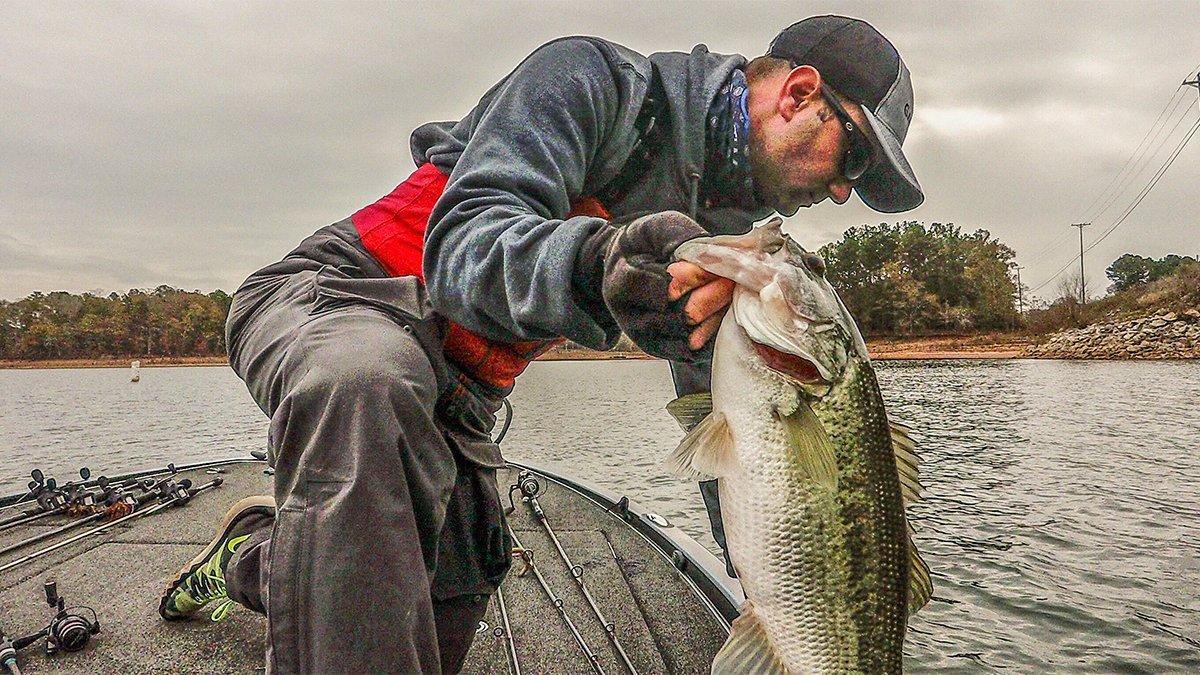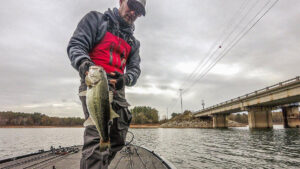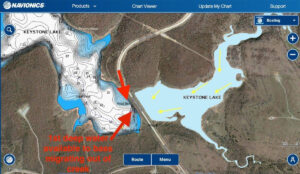Bass fishing in the winter can be an intimidating time to fish for many anglers across the country; water temperatures plummet and so do the activity levels of bass and other aquatic creatures. Their feeding windows become shorter and feeding zones become smaller and more isolated to specific areas.
Professional angler Matt Lee makes his living understanding how seasonal weather changes affect bass. Lee knows bass fishing in the winter can often be feast or famine, due in large part to bass populations being less spread out in cold water conditions. Fortunately if you find one bass this time of year, you’re liable to find many more in the same general location.
?He has learned some tricks on how to eliminate dead water and key in on a few specific structure types to help find schools of bass in cold-water scenarios.
Channel swing banks
“As water temperatures become cooler and winter settles in, you want to narrow your search down to areas with good depth,” Lee said. “Now ‘good depth’ is going to be different depending on what kind of fishery you’re on and the water color you’re experiencing. But first things first, a bass in cold water wants to be around deep water; somewhere they can move both horizontal and vertically.”
Whether it’s Lake Guntersville or Sam Rayburn, channel swing banks are tried and true locations that Lee keys in on to find relatively deep water in close proximity to shallow cover. Instead of fishing through long stretches of shoreline, Lee focuses where a river or creek channel tucks up to the bank.
“Anytime I see contour lines bunched up tightly against a bank on my electronics I know it’s a place worth fishing in the winter,” Lee explained. “The Garmin electronics I run have ‘depth shading’ which shows each depth zone in a contrasting color, which makes it extremely easy to pick out opportune areas. Even without this feature, channel swing banks are easy to distinguish on most lakes by looking at a contour map.”
These channel swing banks give bass the ability to sit in shallow or deep water in close proximity to one another. These banks are often littered with natural rock, boulders, laydowns and stumps. This gives bass excellent ambush points for prey while providing anglers specific, easy-to-locate targets.
Offshore channel swings/drains
You may read the subheading and think offshore channel swings sound a lot like channel swing banks. And in some ways, you’d be right. An offshore channel swing, or a drain as Lee referred to them, is essentially the same thing as a channel swing bank except it’s happening offshore, 10 to 50 feet below the surface. The same tightly bunched contour lines that identify a channel swing bank reveal potential offshore drains.
“Finding productive drains in the winter can result in some unreal days on the water,” Lee said. “They’re harder to find than channel swing banks but they can often be worth the extra search time. Look for places where a river or creek channel turns next to a flat or long, shallow stretches of water. Not every drain will have bass around it, but when you find one that does you’ll likely have a little off the bank sweet spot all to yourself.”
The depth Lee looks for these drains in changes depending on the fishery, the water clarity and the water temperature. The clearer and colder the water, the deeper Lee explores for productive drains. If faced with cold, dirty water Lee still looks for bass relating to drains but he looks for them in 5 to 10 feet of water as opposed to 20 to 30-foot depths.
“Often times, productive offshore drains or channel swings have natural rock where the river channel meets the shallower water,” Lee explained. “The submerged river channel will have eroded the bottom and churned up rock, wood and other debris which bass live around. Drag a Strike King Tour Grade Finesse Jig through the heaviest cover you can find on a drain or throw a Strike King KVD Deep Jerkbait over top of it. If they are in the area the bass should be unpressured and will be quick to show themselves.”
Bridges
Bridges are Lee’s last hotspot for cold-water bass. It’s no secret that a bridge makes for an excellent place to target bass in frigid water–they typically receive a lot of fishing pressure and for good reason. Bridges are a proverbial one-stop shop for bass throughout the cold-water months. Offering deep water in close proximity to shallow water, an ample amount of baitfish and other forage and a pinch point, which creates natural current or intensifies generated current.
“Even though they’re generally regarded as community holes, don’t avoid bridges in cold water situations,” Lee advised. “A bridge is one of the best places to get a bite no matter what time of year you’re fishing. In the spring, bass move through bridges to head to spawning flats and in the winter, bass move back through bridges migrating to deep wintering holes. So take five to ten minutes and fish through a bridge this time of year. Fishing pressure is curbed in the winter and you could have a bridge beatdown all to yourself.”
While all bridges likely have bass somewhere around them, not all bridges are created equal to Lee when it comes to cold-water scenarios. Experience has taught Lee there are a few key factors that lead to certain bridges being other than others, and he refines his search with these details to give him the best chance for finding feeding bass in cold water.
“I look for bridges in the back half of major creeks arms during the winter months,” Lee said. “A perfect wintertime bridge to me would be towards the back of a major cove (or creek), and it would flatten out or get shallower behind the bridge as you moved towards the back of the cove. Meaning the bridge channel and bridge itself would be the first deep water fish in that creek have available to them, creating a perfect scenario for finding fish migrating out of shallow water for winter. Drag a jig, a shaky head or crank a crawfish-colored Strike King Lucky Shad around and you’ll catch some bass.“
Don’t be overwhelmed with the thought of cold-water bass fishing and don’t spend your time fishing dead water this winter. Follow the insight Matt Lee divulged in this piece and focus your efforts where you’re most likely to be rewarded. Each lake has countless areas you can catch bass when the water cools for winter, but the three Lee lays out above apply to most every fishery and will help you find active bass on your next winter fishing trip.
















